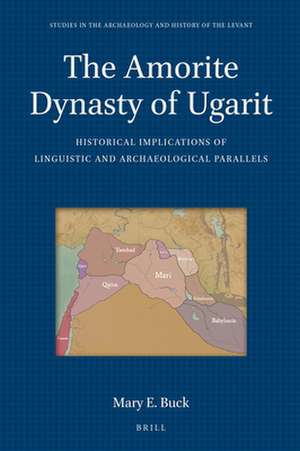The Amorite Dynasty of Ugarit: Historical Implications of Linguistic and Archaeological Parallels: Studies in the Archaeology and History of the Levant, cartea 8
Autor Mary E. Bucken Hardback – 25 sep 2019
With a deft hand, Dr. Buck pursues a nuanced view of populations in the Bronze Age Levant, with the objective of understanding the ancient polity of Ugarit as a kin-based culture that shares close ties with the Amorite populations of the Levant.
"The author covers a contentious area of scholarship with confidence and competence, and has produced a convincing case for the Amorite origins of Bronze Age Ugarit."
-Nick Wyatt, Journal for the Study of the Old Testament 44.5 (2020)
The Studies in the Archaeology and History of the Levant series publishes volumes from the Harvard Museum of the Ancient Near East. Other series offered by Brill that publish volumes from the Museum include Harvard Semitic Studies and Harvard Semitic Monographs, https://hmane.harvard.edu/publications.
Preț: 1232.06 lei
Preț vechi: 1502.51 lei
-18% Nou
Puncte Express: 1848
Preț estimativ în valută:
235.86€ • 242.57$ • 195.67£
235.86€ • 242.57$ • 195.67£
Carte indisponibilă temporar
Doresc să fiu notificat când acest titlu va fi disponibil:
Se trimite...
Preluare comenzi: 021 569.72.76
Specificații
ISBN-13: 9789004415102
ISBN-10: 9004415106
Pagini: 376
Dimensiuni: 155 x 235 mm
Greutate: 0.68 kg
Editura: Brill
Colecția Brill
Seria Studies in the Archaeology and History of the Levant
ISBN-10: 9004415106
Pagini: 376
Dimensiuni: 155 x 235 mm
Greutate: 0.68 kg
Editura: Brill
Colecția Brill
Seria Studies in the Archaeology and History of the Levant
Cuprins
Acknowledgements
List of Figures and Tables
Abbreviations
1 Introduction
1.1 History of the Site of Ugarit
1.2 Methodological Approach
1.3 Material and Linguistic Sources: An Interdisciplinary Approach to History
1.4 Uncharted Areas and Blind Spots: Aim and Trajectory of the Present Study
2 Amorites, Canaanites, and the Emergence of Urbanism
2.1 Introduction
2.2 Interpretations for the Patterns of Urbanism
2.3 The Genetic Classification of Ugaritic in the Semitic Language Tree
2.4 The Historical Convergence of Material Culture and Linguistic Subgrouping
3 Methodology and Terminology
3.1 Archaeological Corpus, Methodology, and Definitions
3.2 Historical Terminology
3.3 Linguistic Corpus, Methodology, and Definitions
3.4 Linguistic Terminology
3.5 Conclusion
4 The Amorite Cultural Koiné
4.1 Archaeological Overview
4.2 Middle Bronze IIB-Late Bronze I Material Assemblage of Ugarit
4.3 The Amorite Material Koiné
5 Northwest Semitic in the Bronze Age Levant
5.1 Introduction
5.2 Methodological Challenges
5.3 Methodological Approach
5.4 Central Semitic
5.5 Northwest Semitic
5.6 Aramaic and Canaanite Subbranches
5.7 Historical Evidence for the Canaanite Languages
5.8 Unique Features of Western Amorite
5.9 The Genetic Subgrouping of Western Amorite
5.10 Western Amorite Onomastic Evidence for the Middle Bronze Pantheon
5.11 Conclusion
6 Conclusion
6.1 Historic Emergence of Ugarit, Canaan, and the Amorites
6.2 Middle Bronze Age Material Assemblage of Ugarit
6.3 Development of the Northwest Semitic Languages in the Bronze Age
6.4 The Local Amorite Dynasty of Ugarit: Historical Conclusions
6.5 Legacy of Complexity: Historical Implications
Appendix A: Western Amorite Corpus
Appendix B: Western Amorite Lexicon
Bibliography
List of Figures and Tables
Abbreviations
1 Introduction
1.1 History of the Site of Ugarit
1.2 Methodological Approach
1.3 Material and Linguistic Sources: An Interdisciplinary Approach to History
1.4 Uncharted Areas and Blind Spots: Aim and Trajectory of the Present Study
2 Amorites, Canaanites, and the Emergence of Urbanism
2.1 Introduction
2.2 Interpretations for the Patterns of Urbanism
2.3 The Genetic Classification of Ugaritic in the Semitic Language Tree
2.4 The Historical Convergence of Material Culture and Linguistic Subgrouping
3 Methodology and Terminology
3.1 Archaeological Corpus, Methodology, and Definitions
3.2 Historical Terminology
3.3 Linguistic Corpus, Methodology, and Definitions
3.4 Linguistic Terminology
3.5 Conclusion
4 The Amorite Cultural Koiné
4.1 Archaeological Overview
4.2 Middle Bronze IIB-Late Bronze I Material Assemblage of Ugarit
4.3 The Amorite Material Koiné
5 Northwest Semitic in the Bronze Age Levant
5.1 Introduction
5.2 Methodological Challenges
5.3 Methodological Approach
5.4 Central Semitic
5.5 Northwest Semitic
5.6 Aramaic and Canaanite Subbranches
5.7 Historical Evidence for the Canaanite Languages
5.8 Unique Features of Western Amorite
5.9 The Genetic Subgrouping of Western Amorite
5.10 Western Amorite Onomastic Evidence for the Middle Bronze Pantheon
5.11 Conclusion
6 Conclusion
6.1 Historic Emergence of Ugarit, Canaan, and the Amorites
6.2 Middle Bronze Age Material Assemblage of Ugarit
6.3 Development of the Northwest Semitic Languages in the Bronze Age
6.4 The Local Amorite Dynasty of Ugarit: Historical Conclusions
6.5 Legacy of Complexity: Historical Implications
Appendix A: Western Amorite Corpus
Appendix B: Western Amorite Lexicon
Bibliography
Notă biografică
Mary E. Buck, Ph.D. (2018), completed her degree at the University of Chicago in Near Eastern Languages and Civilizations. She has published on ancient archaeology, papyri, and inscriptions, and is currently working on a manuscript regarding the history of the Canaanites.
Recenzii
“At every stage, the discussion gives a full account of scholarship on all the main points of controversy, and recognises the limitations of our knowledge so far. The study concludes with two appendices, a list of Amorite personal names, and an Amorite lexicon. The author covers a contentious area of scholarship with confidence and competence, and has produced a convincing case for the Amorite origins of Bronze Age Ugarit.”
- Nick Wyatt, in Society for Old Testament Study Book List 2020
- Nick Wyatt, in Society for Old Testament Study Book List 2020







